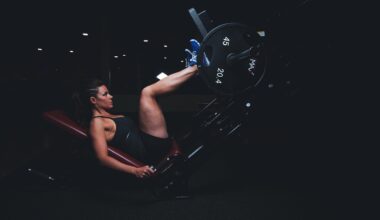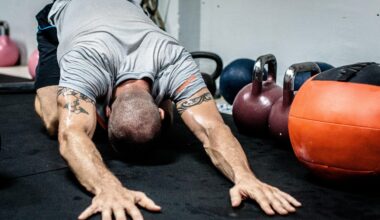How Traction Patterns Affect Parkour Performance
When it comes to parkour, the choice of footwear can greatly impact your performance. Traction is key for executing various techniques, such as jumps, landings, and wall runs. In parkour, a shoe must provide the right traction to help you maintain your grip on multiple surfaces. As you navigate through urban landscapes, the right shoes can keep you safe from slips and falls. Take, for instance, shoes with rubber outsoles that are specifically designed for grip. Typically, these shoes allow for better adherence to walls, rails, and other surfaces. Additionally, different tread patterns can provide varying levels of grip, which can influence your confidence during movements. On smoother surfaces, for example, a shoe with a flat sole may glide better, whereas on textured terrain, a more aggressive pattern can prove beneficial. As parkour practitioners emphasize safety and fluidity, understanding your shoe’s traction can be crucial. Consider testing shoes in different environments to better grasp how traction works. Ultimately, finding the right footwear could enhance your overall parkour experience and allow you to progress further.
In addition to traction, the shoe profile plays a significant role in performance. A low-profile shoe typically offers better feel and balance, giving you the necessary feedback as you execute moves. However, that can sometimes come at the expense of cushioning and support. High-top shoes, on the other hand, provide ankle support for those who need it. But keep in mind that adding a higher collar can limit your foot’s natural movement. Therefore, finding that perfect balance between support and flexibility becomes essential. Shoes equipped with padding should also not compromise the sole’s ability to maintain close contact with the ground. When choosing footwear for parkour, consider how each element aligns with your style. A shoe that accommodates your personal preferences will work better in any scenario you encounter. Furthermore, your local environment plays a role. If you consistently train in urban settings, a shoe designed with city terrains in mind can optimize your skills. Evaluate shoe materials too, such as breathability; since sweat can impact grip, consider changes in weather when choosing shoes.
Importance of Material in Parkour Shoes
Material choice is crucial in the development of parkour shoes since it influences durability and performance. Lightweight materials can enhance agility but may lack durability; hence, it’s important to choose wisely. Synthetic materials like mesh allow breathability and can keep your feet cool but may not provide the necessary protection against rough edges and surfaces. Leather materials, on the other hand, offer durability but may become heavy when wet. Be sure to assess your shoe’s overall construction. Seamless designs can often reduce the risk of blisters and discomfort during sessions. Features such as reinforced toe caps can also add durability while providing better protection during explosive movements. Attention to detail in design can turn a good shoe into a great one. Flexibility is also vital; shoes need to adapt to your foot’s movements while offering support during dynamic transitions. Ensure the shoe’s construction will accommodate natural foot movement. Custom-fitting options are increasingly popular; they offer unique benefits for individuals who have specific foot shapes and sizes. The right shoe material may ultimately allow you to enhance your skills further.
Texture is another key aspect of shoes that can impact performance in parkour. The surface texture of your shoe’s sole affects grip significantly when engaged in high-intensity activities. A generalized approach suggests that smoother soles may be suitable for interior surfaces, while more textured soles can be advantageous for outdoor terrains. Understanding the specific requirements based on your training environment is essential. When facing slippery surfaces, opt for a shoe with deeper grooves or patterns. This will ensure a firmer grip, especially during quick stops or turns. Different materials will respond uniquely based on texture; therefore, testing out various shoes in different environments is crucial. When you find a shoe that works, consider its adaptability. Shoes designed for parkour should also allow for minimal break-in time. Comfort upon first wear can be an indicator of how well the shoe will perform long-term. Additionally, look for shoes that provide adequate cushioning; this can help absorb shock on impact and reduce injury risk. Ultimately, dedicating time to find the right textured shoes could lead to smoother practice sessions.
Choosing the Right Shoe Fit
Fit is another critical factor in selecting the right footwear for parkour enthusiasts. An incorrect fit can lead to discomfort and even injuries that can impede your ability to train effectively. Finding shoes that fit snugly is important, ensuring they are not too tight or too loose. Remember that a shoe should feel like a second skin; it should move fluidly with your foot during dynamic movements. Loose shoes can cause blisters and inadequate support, while shoes that are too tight can restrict blood flow and movement. Testing shoes standing up and performing basic movements can help identify the right match. Additionally, considering the shape of your foot is essential. Different brands can fit differently, so it may be necessary to try multiple brands to discover the best option. Don’t hesitate to consult size charts for helpful measurements as well. If possible, try walking or doing light jumps in the store before making a purchase to assess comfort. A qualified staff at a specialty store can provide invaluable advice in finding shoes designed for rigorous outdoor activities like parkour.
Another aspect you should consider when choosing parkour shoes is the importance of cushioning. Proper cushioning absorbs the impact during landings, reducing potential injuries notably on your joints. Different shoes offer varying levels of cushioning, so explore what works for you during practice. Consider your training intensity; high-impact sessions may require more cushioning than low-energy ones. However, be cautious not to overdo it; excessive cushioning can sometimes lead to a lack of ground feel or connection with the surface. Striking a balance between adequate cushioning and ground feedback can greatly enhance your overall performance. Shoes with responsive cushioning tend to return energy, offering a beneficial effect in specific situations. On the other hand, minimal cushioning is better for training where flexibility is needed. Test various shoes and understand your needs based on your training style. Furthermore, make sure to change shoes regularly throughout the years to also maintain performance and safety. The shoe design you choose ultimately shapes your execution of parkour movements, influencing your effectiveness and overall enjoyment.
Conclusion: The Right Shoes for Parkour
In conclusion, choosing the right shoes for parkour significantly affects your capability in executing various movements. The traction, material, texture, fit, and cushioning of your shoes, all work in unison to enhance your performance. As you evaluate each aspect, consider your training environment and personal preferences to find the right combination. Do not rush this decision; instead, invest time in testing different models that suit your style and needs. Understanding the nuances of footwear can make a world of difference when you engage in parkour. As you grow in this sport, recognize that the footwear will largely influence not just your technical ability but also your safety. Ultimately, the right pair can bring confidence and encourage you to push your limits. The journey of finding the perfect pair may take time and patience, but ultimately, it significantly enriches your experience. Always remember that investing in quality footwear is important for your growth. Prioritize shoes that not only fit the environment but enhance your training, allowing you to explore the amazing challenges of parkour.
This analysis emphasizes that welcoming new shoes into your practice requires careful consideration. Start by researching ahead of time to narrow your options. As trends in parkour evolve, so do the innovations in footwear. Staying updated on new models and improvements can lead to finding shoes that enhance performance. Many experienced practitioners share insights on the best brands and features, which can provide valuable guidance. Resources to explore include forums, blogs, and dedicated parkour websites, where real-life experiences help illuminate your decision-making process. Actively engaging in discussions with your peers may also lead you to discover brands that offer the performance benefits you seek. Don’t forget to prioritize comfort while seeking durability; this combination can prove game-changing. Lastly, always document your shoe performance as you incorporate new models into your regimen to observe what works and what doesn’t over time. By taking a strategic and well-researched approach, you enhance your training sessions and reduce the risk of injuries. As you proceed, embracing all aspects of footwear to complement your parkour journey will ultimately set you on a positive and rewarding path.


